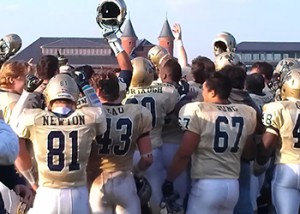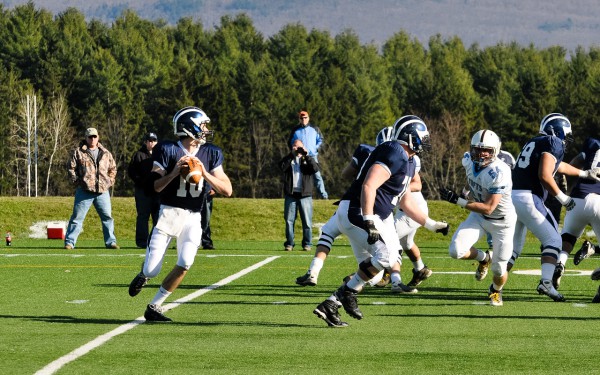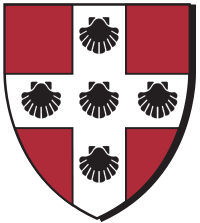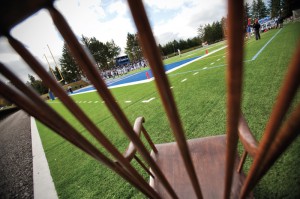This post has been edited to correct a number of errors in the first publishing. We apologize for the mistakes.
1st Team Offense
QB – McCallum Foote, Middlebury
RB – Evan Bunker, Trinity
RB – Ben Crick, Trinity
RB – LaDarius Drew, Wesleyan
WR – Luke Duncklee, Colby
WR – Matt Minno, Middlebury
WR – Joe Jensen, Hamilton
TE – Billy Sadik-Kahn
OL – Rob Wasielewski, Amherst
OL – Jack Allard, Middlebury
OL – Paul Gallagher, Colby
OL – Liam O’Neil, Bates
OL – Jacob Sheffer, Wesleyan
K – Sebastian Aguirre, Wesleyan
There isn’t much to defend here and people’s first teams will likely look roughly the same. The offensive line is always the most difficult group to select, so if we’ve missed any major names we apologize. The backfield looks similar to 2012, with Foote and Bunker receiving their third straight first team nominations after leading the NESCAC in passing and rushing yards, respectively, for the third year in a row. Drew, meanwhile, was an obvious choice, leading the conference in rushing touchdowns and missing out on a NESCAC rushing title by just 6 yards while carrying the ball 9 fewer times than Bunker. We spent a considerable amount of time discussing the merits of a number of different players for the third and final running back spot, including Kyle Gibson, Zach Donnarumma and James Stanell, but ultimately we chose Crick based on a number of different factors. First, only Gibson and Sean Doherty outrushed Crick on a per-carry basis and he averaged 6.5 more yards per game than Gibson and 12.4 more than Doherty. Donarumma and Stanell, meanwhile, were hurt by their relatively meager per-carry averages and in Stanell’s case, an injury that caused him to miss two games, as well as ball security issues that led to four fumbles. The better question might be why Crick over Gibson. Here, Jeff and I felt that the biggest difference was that Crick was at his best—often better than Bunker—when Trinity needed him most. The same could not be said of Gibson. Crick outrushed Bunker in all three of Trinity’s games decided by a touchdown or less, averaging just over 92 yards on 5.2 yards per carry, and was the more dangerous and effective back for much of the season. Gibson, meanwhile, mirrored Drew’s down numbers in those games, averaging just 52.7 yards per game in close games and losses, while carrying the ball for 4.5 yards per carry. Ultimately the two are similar players playing similar roles in similar offenses, but we felt that Crick played a bigger role in Trinity’s success, and performed better when he needed to, than Gibson did. At the wide receiver spot, we felt the first two selections were pretty obvious (as was tight end). The third choice was more difficult, however, and came down to Jensen, Brendan Rankowitz and Brian Ragone. Ultimately, we settled on Jensen who, in addition to leading the NESCAC in yards per catch (if only because Ragone doesn’t qualify) is also a tremendous kick returner. At kicker, Aguirre separated himself from the group with his consistency over a high volume of attempts. He made 9 of 11 field goals, including a 41-yarder, and converted 29 of 30 point after tries.
1st Team Defense
DL – James Howe, Williams
DL – Max Lehrman, Amherst
DL – Caleb Harris, Colby
DL – Jake Prince, Bowdoin
LB – Chris Tamasi, Amherst
LB – Joey Cleary, Bowdoin
LB – Brian Glazewski, Bowdoin
LB – Tim Patricia, Middlebury
DB – Landrus Lewis, Amherst
DB – Andrew Kukesh, Bates
DB – Brian Dones, Trinity
DB – Jason Buco, Colby
P – Mike Dola
There also wasn’t too much to discuss on the first team defense. There seemed to be four standouts across the conference on the defensive line, with a pretty substantial gap between the four first team selections and the guys who followed them. Linebacker wasn’t quite as straightforward, but again, it seemed that this group separated itself from the rest of the conference’s backers. Cleary led the conference by a wide margin with 99 tackles, making him a first-team selection shoo-in. The same can be said for Chris Tamasi, who recorded a conference-best 18 tackles for a loss. The only other backer to register more than 10 was Glazewski, another first team selection of ours, who also added 72 tackles, three sacks and four fumble recoveries. Our final linebacker spot went to Patricia, who was the heart of a much improved Middlebury defense, and responsible for alligning the defense before every play. Patricia joined Cleary as one of just two linebackers to make at least 70 tackles, 2 sacks and an interception this season. In the defensive backfield, Landrus Lewis didn’t put up great numbers, but we suspect—and it was confirmed when we saw him play—that this was because teams avoided his side of the field. He still registered a league-high 3 interceptions, likely on far fewer targets than the 9 other players who achieved the same feat. Kukesh, a preseason All-American, was excellent in all phases defensively, picking off 3 passes, while making 7.5 tackles for loss and 81 tackles overall. He even slid over and played linebacker at times this year due to injuries sustained by his teammates. Dones, meanwhile, led the league with 11 pass breakups—4 more than any other defensive back—in addition to his 3 interceptions and same number of tackles for loss. The final defensive back spot went to Buco, who excelled in coverage, blitzing off the edge and filling in against the run. Buco broke up 6 passes, intercepted 2 more, sacked the quarterback twice and made 5.5 tackles for a loss. He also used his size, speed and ball skills on the other side of the line of scrimmage, hauling in a 19-yard reception against Middlebury. Dola had a spectacular season, despite limited attempts. The junior specialist led the NESCAC in punting, with a 41.0 yard average and downed 10 punts inside the 20-yard line on just 28 punts.
2nd Team Offense
QB – Justin Ciero, Colbyhi
RB – Zach Donarumma, Bowdoin
RB – Kyle Gibson, Wesleyan
RB – James Stanell, Hamilton
WR – Brian Ragone, Trinity
WR – Brendan Rankowitz, Middlebury
WR – Jake O’Malley, Amherst
TE/FB – Mike Budness, Trinity
OL – Ben Green, Middlebury
OL – Nick Noonan, Hamilton
OL – Jake Golden, Trinity
OL – Mike Bernstein, Bates
OL – Pat DiMase, Wesleyan
K – Phil Nwosu
Ciero over Jesse Warren might be the first big point of contention for people. While Warren played mistake-free football for 7 games this year, we felt that his final numbers and limited role opened the door for a player with messier numbers, but greater value. That player was Ciero, who accounted for nearly 2000 yards of total offense, adding over 500 yards rushing—the 9th most in the conference to his 1,454 yards of passing (3rd in the NESCAC). Though Warren threw just 3 interceptions (versus 15 touchdown passes), no starting quarterback, that is to say, no starter who held his job throughout the season, dropped back to pass fewer times than Warren. Had Warren finished the season with 20 touchdown passes and led an undefeated Wesleyan team to a NESCAC title, this decision might have gone differently, but ultimately Ciero meant more to Colby—and was a better player overall in 2013—than Warren. At the final running back position we considered Sean Doherty, but felt the difference of nearly 19 yards per game between Doherty’s per game average and Stanell’s concluded the discussion. The final wide receiver spot came down to Josh Hurwitz and Ragone. Though he was lightly utilized by the Bantams, Ragone’s NESCAC-leading 18.7 yards per reception and 4 touchdowns distinguish him from Hurwitz and the other wide receivers who did not make this list. Nwosu converted just 71 percent of his field goal tries, but all all of his misses—with the exception of a blocked field goal—came from 30 yards and beyond. Twice he made field goals longer than 40 yards, including a 44-yarder in Amherst’s 1-point win over Trinity. Ben Rosenblatt received considration here, but his 7 missed extra points, including a crucial one in the loss against Amherst, kept him off this list.
2nd Team Defense
DL – Nathan Cyr, Trinity
DL – Tucker Oniskey, Bates
DL – Tom Wells, Bowdoin
DL – Jake Clapp, Middlebury
LB – Henry Nelson, Colby
LB – John Phelan,Hamilton
LB – Matt McCormack, Tufts
LB – Ned Deane, Amherst
DB – Nate Leedy, Middlebury
DB – Max Dietz, Amherst
DB – Matt Benedict, Middlebury
DB – Jimmy Fairfield-Sonn, Amherst
P – Joe Mallock, Williams
The difficult part of making the second team defense was accounting for all the linebackers and defensive backs who deserved to make an All-NESCAC team. On the defensive line, Oniskey had a unique season, breaking up 9 passes on the season, making him the NESCAC’s version of JJ Watt. Clapp, meanwhile, registered 4.5 sacks, the fourth most in the NESCAC, from his outside linebacker/defensive end position and was a matchup nightmare for opposing tackles as the season wore on. In the linebacking coprs, McCormack quietly had the conference’s second most tackles this season, while Ned Deane did a little bit of everything, making 71 tackles, 10 tackles for loss, including 4 sacks as well as 3 pass breakups. In the defensive backfield, freshman corner Nate Leedy gets our vote. Leedy was solid in all aspects of the game, playing a unique brand of press coverage and using his physicality to disrupt receivers route patterns as well as a weapon against ball carriers who ventured to his side of the field. Statistically, Leedy finished his freshman season with 7 pass breakups, trailing only Dones among defensive backs in that category. That number would have been considerably higher, but teams have thrown away from his side of the field over the second half of the season. Leedy also made 45 tackles on the season, more than just about every other corner in the league and made plays primarily as a run stopper rather than tackling receivers after the catch. In the second game of the season against a run-heavy Colby team, Leedy made 10 tackles, including 2 for a loss. Benedict is the second member of the Middlebury secondary on our team. He earned his spot as the leader of Middlebury’s secondary and his constant presence around the football. Only Kukesh, who played linebacker at times this year as well, finsihed with more tackles from the safety position than Benedict. Another pair of teammates, Max Dietz and Jimmy Fairfield-Sonn, round out the second-team defensive backfield. Dietz had 3 interceptions to go along with 6 pas sbreakups, while Fairifield-Sonn made 53 tackles, 2 interceptions and 6 pass breakups. Mallock rounds out the specialists, earning the spot not so much on his per-punt average (just 36.5 yards) but because he downed 15 punts inside the 20 (second most in the conference) and led the conference with 20 fair catches. By comparison, Kyle Pulek, who was second in the conference in punting average at 39.3 yards per kick, forced only 5 fair catches.
Offensive Player of the Year: McCallum Foote
Foote certainly wouldn’t have gotten our vote at the midway point of the season, but what accomplished over the second half of the season surpasses any other four-game stretch of his career. After one of the finest performances of his career—irrespective of his statistical output—in the win over Trinity, Foote followed that with two of the most amazing statistical performances in NESCAC history, throwing for 732 yards, 12 touchdowns, 1 interception, while completing more than 73 percent of his passes over the final two games of the season. No single player meant more to his team week in and week out than Foote and as the season progressed his performance began to better exemplify that.
Defensive Player of the Year: Joey Cleary
Cleary was the NESCAC’s most proficient tackler, finsihing the season one tackle shy of 100. He was unblockable for large parts of Middlebury’s meeting with Bowdoin, making 15 tackles, recording an interception of Foote and accounting for Bowdoin’s first two points of the game on an A-gap blitz, which resulted in a safety on a tackle of Matt Rea in the end zone. In addition to his 99 tackles, Cleary added 1.5 sacks, 8.5 tackles for a loss, a pair of interceptions and 4 pass breakups. He jumped off the screen and stat sheet alike.
Rookie of the Year: Nate Leedy
We laid out most of the case for Leedy above, but it deserves reiterating: he was fantastic all year long in all aspects of Middlebury’s defense. While the NESCAC isn’t known for its press-man coverage on the outside, Leedy often corwded and jammed wide receivers at the line of scrimmage to disrupt their routes and demonstrated great closing speed and an ability to make a play on the ball when he was targeted. There isn’t a player on either side of the ball whose future is as bright as Leedy’s.
Coach of the Year: Mike Whalen
Whalen did a phenomenal job building Wesleyan’s roster. Most of the significant contributors this year were juniors, who should step into similar, if not bigger roles next season, making Wesleyan enormous favorites—given the rest of the NESCAC landscape—to defend their 2013 crown. It wouldn’t surprise me, therefore, to see Whalen win this award a couple of times in the coming years if the program continues to attract the athletes that it has over the past couple of years. Whalen also did a great job, at least early in the season, preparing his team, which dominated opponents in all phases of the game, often right out of the gate—a testament to Whalen’s tactical coaching skills in addition to his prowess as a recruiter.



